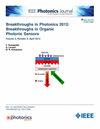Extension of the CNN-Based Demodulation Method for Image Sensor-Based Visible Light Communication Considering Real Image Parameters
IF 2.4
4区 工程技术
Q3 ENGINEERING, ELECTRICAL & ELECTRONIC
引用次数: 0
Abstract
This paper proposes a convolutional neural network (CNN)-based demodulation method to enhance the performance of visible light communication (VLC) between digital signage and mobile terminals such as smartphones. Unlike conventional methods, the proposed approach employs a sliding window mechanism to enable flexible demodulation of data signals of arbitrary size by scanning a compact CNN trained to demodulate考虑真实图像参数的基于cnn的图像传感器可见光通信解调方法的扩展
本文提出了一种基于卷积神经网络(CNN)的解调方法,以提高数字标牌与智能手机等移动终端之间可见光通信(VLC)的性能。与传统方法不同,本文提出的方法采用滑动窗口机制,通过扫描经过训练的紧凑CNN来解调$3 \ × 3$数据信号单元,从而实现任意大小数据信号的灵活解调。该模型还结合了周围细胞的空间背景,以提高对符号间干扰的鲁棒性。为了确保对现实世界条件的适应性,CNN使用模拟接收的图像进行训练,这些图像再现了从实际捕获的图像中提取的退化效应,如噪声、模糊和位移。在使用OLED显示器和USB摄像头的室内实验设置中,对所提出的方法进行了评估,复制了标牌和图像传感器之间的实际通信场景。通信实验采用麦克白色表中的24种单色背景色,在YCbCr色彩空间中对Cb分量施加不同的信号强度。结果表明,该方法明显优于传统的基于阈值的解调方法,特别是在低信号强度条件下,从而证明了其在实际应用中的有效性。
本文章由计算机程序翻译,如有差异,请以英文原文为准。
求助全文
约1分钟内获得全文
求助全文
来源期刊

IEEE Photonics Journal
ENGINEERING, ELECTRICAL & ELECTRONIC-OPTICS
CiteScore
4.50
自引率
8.30%
发文量
489
审稿时长
1.4 months
期刊介绍:
Breakthroughs in the generation of light and in its control and utilization have given rise to the field of Photonics, a rapidly expanding area of science and technology with major technological and economic impact. Photonics integrates quantum electronics and optics to accelerate progress in the generation of novel photon sources and in their utilization in emerging applications at the micro and nano scales spanning from the far-infrared/THz to the x-ray region of the electromagnetic spectrum. IEEE Photonics Journal is an online-only journal dedicated to the rapid disclosure of top-quality peer-reviewed research at the forefront of all areas of photonics. Contributions addressing issues ranging from fundamental understanding to emerging technologies and applications are within the scope of the Journal. The Journal includes topics in: Photon sources from far infrared to X-rays, Photonics materials and engineered photonic structures, Integrated optics and optoelectronic, Ultrafast, attosecond, high field and short wavelength photonics, Biophotonics, including DNA photonics, Nanophotonics, Magnetophotonics, Fundamentals of light propagation and interaction; nonlinear effects, Optical data storage, Fiber optics and optical communications devices, systems, and technologies, Micro Opto Electro Mechanical Systems (MOEMS), Microwave photonics, Optical Sensors.
 求助内容:
求助内容: 应助结果提醒方式:
应助结果提醒方式:


